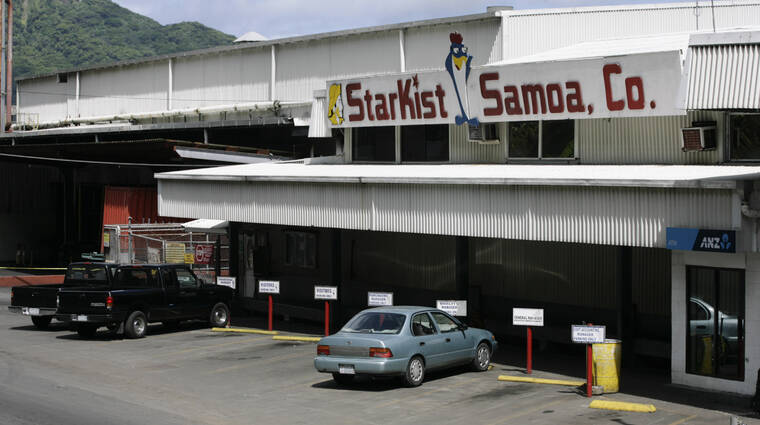Opposition to marine sanctuary voiced during Wespac meeting

ASSOCIATED PRESS FILE
Employees of the StarKist tuna cannery, located in American Samoa, protested the proposed sanctuary, fearing that it could lead to the closure of the cannery.
Opponents of a proposed national marine sanctuary in the U.S. Pacific Remote Islands, in particular tuna cannery employees in American Samoa, protested and testified against the sanctuary today during a Western Pacific Regional Fishery Management Council meeting that’s being held in the territory.
The council, known as Wespac, is holding a multi-day meeting covering a variety of fishing-related issues in the Pacific Ocean, including the ongoing process to turn the Pacific Remote Islands Marine National Monument (PRIMNM) into a sanctuary and expand it into the largest marine protected area in the world.
Employees of the StarKist tuna cannery, located in American Samoa, took the opportunity to protest the proposed sanctuary, fearing that it could lead to the closure of the cannery.
They attended the Wespac meeting today as the council provided an update on the sanctuary designation process. More than a dozen workers and opponents of the sanctuary could be seen holding signs with messages saying “StarKist Samoa cannery takes care of my family” or “I’m a cannery worker; save my job.”
The sanctuary would close off commercial fishing to about 780,000 square miles of U.S. waters around Baker, Howland and Jarvis islands; Johnston, Wake and Palmyra atolls; and Kingman Reef. Opponents have warned that the sanctuary’s most significant effect would be the closure of the cannery, which employs 14% of American Samoa’s workforce and is its largest private employer, according to a 2020 report Opens in a new tab on the territory’s economy by the U.S. Government Accountability Office. Canned tuna represents about 90% of the territory’s exports, the report said.
The council and its staff have been vocal opponents of the monument’s expansion and sanctuary designation for months, but the protest and public testimonies amplified that position.
Don't miss out on what's happening!
Stay in touch with breaking news, as it happens, conveniently in your email inbox. It's FREE!
“We have a two-pillared economy: government and (the tuna) fishery. And both are fragile,” said Fuiavailili Keniseli Lafaele, described by Samoa News as the former director of commerce for American Samoa, in testimony. “To expand this monument will probably be the nail in the coffin.”
American Samoa’s economy shrank between 2007 and 2017, in part because its tuna canning industry is facing increased competition and labor market challenges, according to the GAO report. Tuna supply has also been a factor.
Nate Ilaoa, a former Wespac staffer and restaurant owner in American Samoa, said the expansion puts the local economy in “extreme jeopardy.” The canning industry subsidizes shipping and fuel costs for other businesses, which will then suffer if the industry collapses, he said.
Public testimony echoed grievances from Wespac about the lack of public outreach and input on the sanctuary from those who would be affected the most.
American Samoa Gov. Lemanu Peleti Mauga on Tuesday opened the council meeting with a speech about his frustration with the sanctuary designation process so far.
“There is no equity and justice served when the people that these federal actions will impact have no say, and no voice,” he said. “Respect is a very important aspect to the Pacific people, and I call on our federal partners to show some respect — sit down with us, talk with us and not to us.”
In a Wespac meeting in April, the governors of Guam and the Commonwealth of the Northern Mariana Islands also warned of the unintended consequences of the monument expansion and urged NOAA and President Joe Biden’s administration to communicate with Pacific island communities.
Wespac today voted to formally request that NOAA “evaluate the holistic impacts of prohibiting tuna fishing” within U.S. federal waters.
Biden in March announced his intent to expand the PRIMNM and form a sanctuary, and the process is still in its early stages. Proponents of the sanctuary argue that it will protect marine ecosystems and allow them to recover from the pressures of commercial fishing.
Several studies, although refuted by Wespac, have suggested that the proposed sanctuary will have little effect on commercial fishing and that marine protected areas can be beneficial for commercial fishing because of their “spillover” effects on fish populations just outside protected areas.
Wespac has regularly opposed additional fishing regulations in the region. Currently it is also proposing a permit allowing subsistence fishers in the Northwest Hawaiian Islands to sell their fish as a “cost recovery” method for fishing trips to the Papahanaumokuakea Marine National Monument expansion area.
NOAA has firmly denied the proposal; opponents of cost recovery say it too closely resembles commercial fishing, which is prohibited in the monument.



